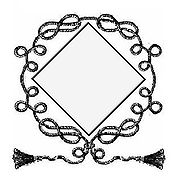
Women in heraldry
Encyclopedia

English heraldry
English heraldry is the form of coats of arms and other heraldic bearings and insignia used in England. It lies within the Gallo-British tradition. Coats of arms in England are regulated and granted to individuals by the College of Arms. They are subject to a system of cadency to distinguish...
, a woman
Woman
A woman , pl: women is a female human. The term woman is usually reserved for an adult, with the term girl being the usual term for a female child or adolescent...
may bear arms by inheritance from her father or by grant to herself. When unmarried, she displays her arms on a lozenge
Lozenge
A lozenge , often referred to as a diamond, is a form of rhombus. The definition of lozenge is not strictly fixed, and it is sometimes used simply as a synonym for rhombus. Most often, though, lozenge refers to a thin rhombus—a rhombus with acute angles of 45°...
(a diamond shape) or on an oval or oval-like shape. Traditionally, a woman does not display her arms on a shield, as the shield originated with knights and warfare, and is thus viewed as fitting for a man, but not a woman. Recently though, some armiger
Armiger
In heraldry, an armiger is a person entitled to use a coat of arms. Such a person is said to be armigerous.-Etymology:The Latin word armiger literally means "armour-bearer". In high and late medieval England, the word referred to an esquire attendant upon a knight, but bearing his own unique...
ous women have chosen to break with tradition and use a shield anyway.
When married, a woman has the option of uniting her arms with those of her husband in what are called marital arms; their arms are impaled
Impalement (heraldry)
In heraldry, impalement is the combination of two coats of arms side-by-side in one shield or escutcheon to denote union, most often that of a husband and wife, but also for ecclesiastical use...
, meaning they are placed side by side in the same shield, with those of the man on the dexter (left, as seen from the front) and those of his wife on the sinister (right, as seen from the front). If one spouse belongs to the higher ranks of an order of chivalry, and is thereby entitled to surround his or her arms with a circlet of the order, it is usual to depict them on two separate shields tilted towards one another, this is termed "accollé".
A married woman may also bear either her own arms or her husband's arms alone on a shield with a small differencing mark to distinguish her from her father or husband. If the woman is an heraldic heiress
Heraldic heiress
In English heraldry an heraldic heiress is a daughter of deceased man who was entitled to a coat of arms and who carries forward the right to those arms for the benefit of her future male descendants...
, her arms are shown on an inescutcheon of pretence, which is a small shield in the centre of her husband's arms. When widowed, a woman continues to use her marital arms, but placed on a lozenge or oval.
Canada
In Canadian heraldryCanadian Heraldic Authority
The Canadian Heraldic Authority is part of the Canadian honours system under the Queen of Canada, whose authority is exercised by the Governor General. The Authority is responsible for the creation and granting of new coats of arms , flags and badges for Canadian citizens, permanent residents and...
, women and men are treated equally for heraldic purposes, as required by Canadian equality laws. It is therefore common to display the arms of women on shields, rather than on a lozenge or oval, but a woman may still choose to have her arms displayed on a traditional shape. Furthermore, the Canadian Heraldic Authority has designated a set of cadency marks for daughters, similar to those used in English heraldry for sons.
See also
- Baron and FemeBaron and FemeIn English law, Baron and Feme is a phrase used for husband and wife, in relation to each other, who were accounted as one person by coverture. Hence, by the old law of evidence, the one party was excluded from giving evidence for or against the other in civil questions, and a relic of this is...

